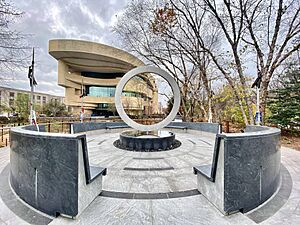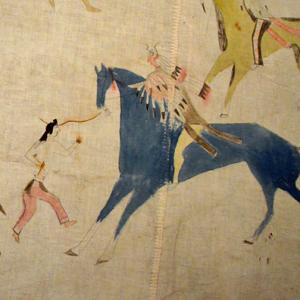National Museum of the American Indian facts for kids
 |
|
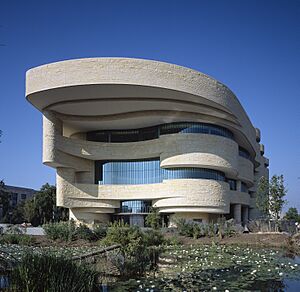 |
|
| Established | 1989 |
|---|---|
| Location | Fourth Street and Independence Avenue, Southwest, Washington D.C. (main location) |
| Visitors | 701,021 (2023) |
| Public transit access | |
The National Museum of the American Indian is a special museum in the United States. It is all about the amazing cultures of the Native peoples of the Americas. This museum is part of the famous Smithsonian Institution, which has many museums and research centers.
The museum has three main places. The biggest one is on the National Mall in Washington, D.C.. It opened on September 21, 2004. There's also the George Gustav Heye Center in New York City, which opened in 1994. This center is in a beautiful old building called the Alexander Hamilton U.S. Custom House. Finally, there's the Cultural Resources Center in Suitland, Maryland. This is where the museum keeps its huge collection of items and does research. The museum's collection started with items from the former Museum of the American Indian in New York City, which began in 1916.
Contents
History of the Museum
The idea for a national museum about Native Americans started in 1982. People wanted a place to celebrate Native American art and culture. A special event was held at the Kennedy Center. An artist named Retha Walden Gambaro helped organize an art show there. She was a big supporter of creating this museum.
In 1989, a law was passed to create the National Museum of the American Indian. This happened after Native American leaders learned that the Smithsonian had many human remains and sacred objects. The new law made the museum "a living memorial to Native Americans and their traditions." It also said that human remains and important cultural items should be returned to tribal communities. Since 1989, the Smithsonian has returned thousands of these items.
On September 21, 2004, the main museum in Washington, D.C., officially opened. It was a huge event! About 20,000 Native Americans, Alaska Natives, and Native Hawaiians gathered in Washington, D.C. This was the largest gathering of Indigenous people there at the time.
The museum's collection mostly came from the George Gustav Heye Center in New York City. This collection joined the Smithsonian in 1990. It makes up about 85% of all the items the museum has today.
Museum Leaders
In January 2022, Cynthia Chavez Lamar became the director of the National Museum of the American Indian. She is a member of the San Felipe Pueblo. This makes her the first Native American woman to lead a Smithsonian museum! She had worked at the museum before, even as an intern in 1994.
Before Cynthia Chavez Lamar, Kevin Gover was the director from December 2007 until January 2021. He is a member of the Pawnee Nation of Oklahoma. He helped lead the museum for many years. The first director of the museum was W. Richard West Jr., who was a Southern Cheyenne tribal member. He led the museum from 1990 to 2007.
Museum Locations
The National Museum of the American Indian has three important locations. These are the main museum in Washington, D.C., the George Gustav Heye Center in New York City, and the Cultural Resources Center in Maryland. There is also a special memorial nearby for Native American veterans.
National Mall (Washington, D.C.)
The main museum building on the National Mall is very unique. Its groundbreaking ceremony was on September 28, 1999. The museum opened its doors on September 21, 2004.
It took 15 years to build this museum. It was the first national museum in the U.S. dedicated only to Native Americans. The building is five stories tall and shaped with curves. It looks like natural rock formations shaped by wind and water. This is because it is covered in golden-colored stone.
The museum is on a 4.25-acre site. It is surrounded by wetlands, which are like marshy areas. The museum's entrance faces east, and it has a tall space for Native performances. These features were designed after talking with many Native peoples. Like the Heye Center, this museum has many exhibits, films, and programs.
The main architect for the museum was Canadian Douglas Cardinal, who is Blackfoot. Other architects and designers also helped. They wanted the museum to feel different from other museums. They wanted it to connect with nature. A botanist named Donna E. House, who is Navajo and Oneida, helped with the landscaping. She said, "The landscape flows into the building, and the environment is who we are." Inside, the museum has mostly curving walls, showing this natural flow.
Mitsitam Native Foods Cafe
The Mitsitam Native Foods Cafe is a special restaurant inside the museum. It has five stations that serve different foods from Native American regions. You can try foods from the Northern Woodlands, South America, the Northwest Coast, Meso-America, and the Great Plains. The museum has even published a cookbook from the cafe!
George Gustav Heye Center (New York City)
George Gustav Heye (1874–1957) loved to travel and collect Native objects. He started collecting in 1903 and continued for 54 years! He used his collection to open the Museum of the American Indian in New York City in 1922.
This museum closed in 1994. Now, part of its collection is at the George Gustav Heye Center. This center is inside the beautiful Alexander Hamilton U.S. Custom House. This building was finished in 1907 and is a very important historical landmark. The Heye Center has many exhibits, films, and cultural presentations all year long.
Cultural Resources Center (Maryland)
In Suitland, Maryland, the museum has its Cultural Resources Center. This huge building is shaped like a nautilus shell. It holds the museum's entire collection, a library, and photo archives. The Cultural Resources Center opened in 2003.
National Native American Veterans Memorial
The National Native American Veterans Memorial is near the museum in Washington, D.C. It honors American Indian, Alaska Native, and Native Hawaiian veterans. These brave people have served in the U.S. Armed Forces in every American conflict since the American Revolution.
The memorial was first approved by Congress in 1994. It was officially shown to the public with an online event on Veterans Day in 2020. A special dedication ceremony was held on November 11, 2022. More than 1,500 Native veterans from over 120 Native nations marched in a procession. The memorial has a steel circle standing on a stone drum. It is surrounded by benches and symbols of the military branches. There are also four steel poles where visitors can tie cloths for prayers and healing.
The memorial was designed by Cheyenne and Arapaho artist Harvey Pratt. It is called Warriors' Circle of Honor.
Museum Collections
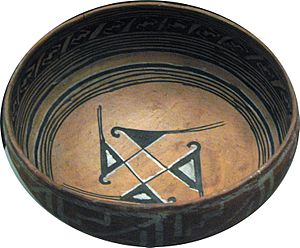
The National Museum of the American Indian has a huge collection of items. It includes more than 800,000 objects! There are also 125,000 photos. The collection is organized by different regions and cultures. These include the Amazon, Andes, Arctic, California, Mesoamerican, Northwest Coast, Plains, and Woodlands.
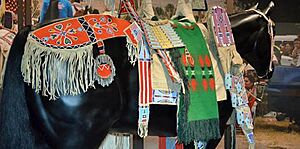
Most of the collection was put together by George Gustav Heye. He collected items from all over North and South America. He started the Museum of the American Indian in New York City in 1922.
The museum works closely with Native American communities. They talk about how to respectfully care for cultural items. For example, the vault where human remains are kept is smudged once a week. This is a special ceremony using tobacco, sage, sweetgrass, and cedar. Sacred Crow objects are smudged with sage during the full moon. If the right way to care for an object is not known, Native staff use their own cultural knowledge. They make sure to treat everything with respect.
The museum also has programs for Native American scholars and artists. They can come and study the collections. This helps them with their own research and artwork.
Exhibits to Explore
Nation to Nation: Treaties
In 2014, the museum opened a new exhibit called Nation to Nation: Treaties. This exhibit explores the history of treaties between Native nations and the United States. It helps visitors understand the importance of these agreements.
American Indian Magazine
| Editor-in-Chief | Tanya Thrasher |
|---|---|
| Frequency | quarterly |
| Circulation | 42,640 |
| Publisher | Smithsonian Institution |
| First issue | 2000 |
| Country | US |
| Website | https://www.americanindianmagazine.org/ |
| ISSN | 1528-0640 |
| OCLC | 43245983 |
The museum publishes a magazine four times a year called American Indian. This magazine shares stories and information about Native Americans. It has won awards for its excellent content. The magazine's goal is to "Celebrate Native Traditions and Communities."
See also
 In Spanish: Museo Nacional de los Indios Americanos para niños
In Spanish: Museo Nacional de los Indios Americanos para niños
- List of most-visited museums in the United States
- Always Becoming
- Ben Nighthorse Campbell
- Daniel Inouye
- George Gustav Heye Center
- List of national memorials of the United States
- National Museum of the American Indian Act





